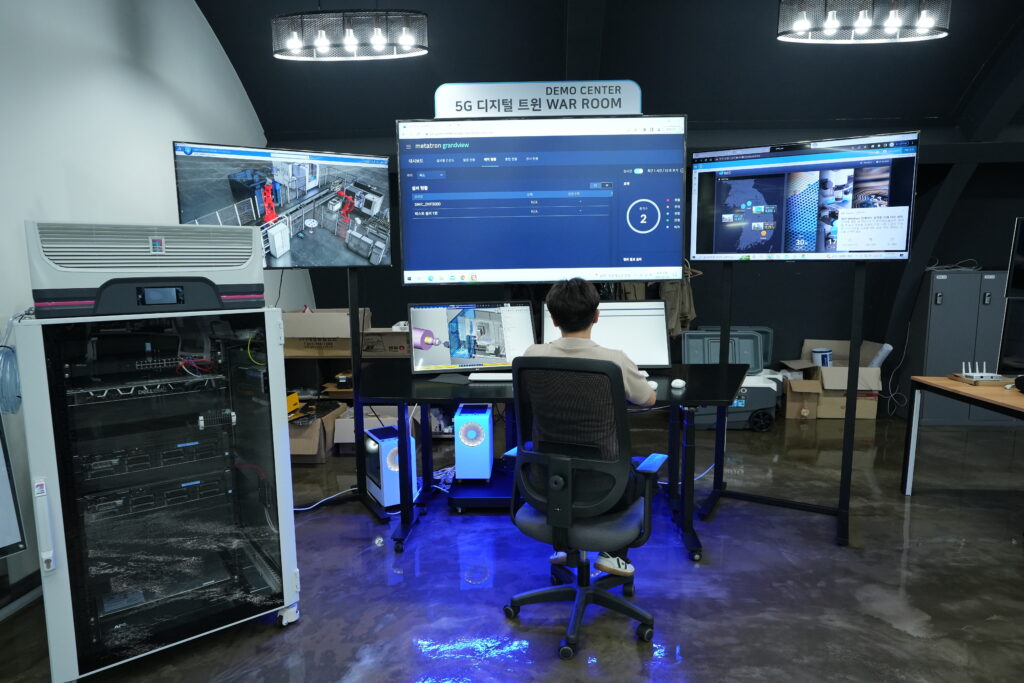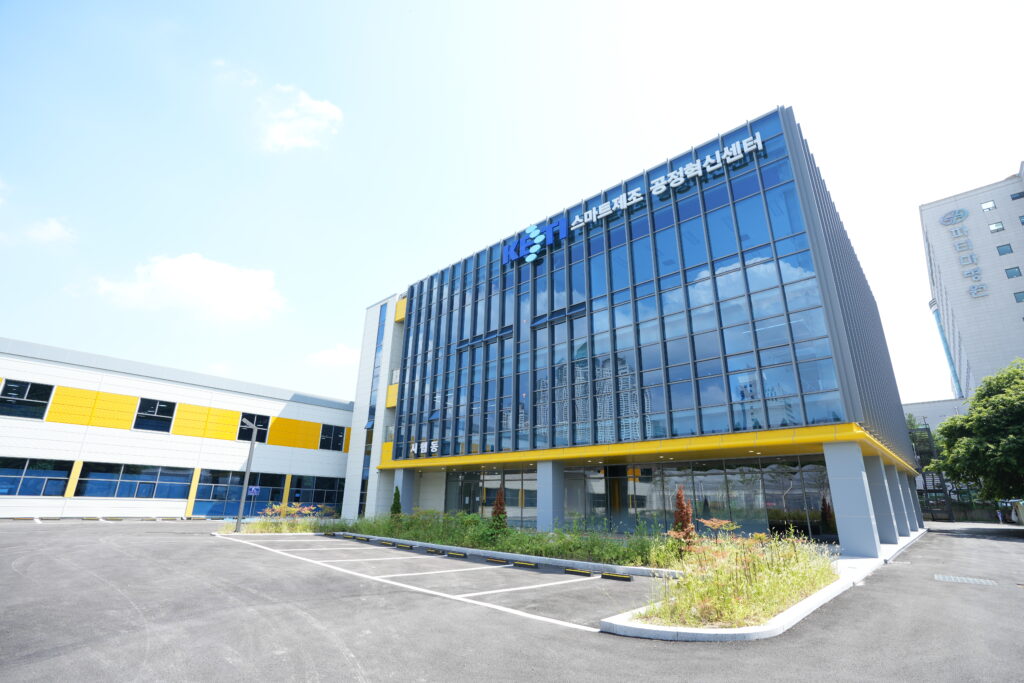ASIA ELECTRONICS INDUSTRYYOUR WINDOW TO SMART MANUFACTURING
SMIC of Korea Serves as Testbed for Future-Proof Smart Factory
Smart factory will finally evolve to think and act on its own right in the same way that cars of today is going smarter and smarter to eventually drive their ways autonomously.
State-funded SMIC, or Smart Manufacturing Innovation Center of Korea is a future-proof testbed of what smart factories of the future will look like.
“Our center here in the city of Changwon is operating on the concept of what’s called as PLS, allowing machines to be flexibly assigned to do tasks parallelly, not linearly nor serially. Each machine is standardized, synchronized, and gets interoperable to decide what to do on its own right and then autonomously load task assignments, continuously staying loaded with jobs around the clock. The synchronization and interoperability help explain why our center is called as a demo line for autonomous smart factories of the future, showcasing how to build future-proof smart factories, Dr. Song Byunghun, director and commissioner with SMIC.
The PLS is a sort of FMS, or flexible manufacturing system that synchronizes the operation of all machines and robots – edge devices – around a centralized cloud computing system to quickly adapt to changes in production schedules as well as in the types and quantities of products.
A walk into the center will show you that a variety of machine tools of different brands are aligned on the factory floor, working out assigned tasks on their own right. And, an army of collaborative robots are also moving their arms in the air to pick and place various metal parts and components on the assigned machine tools.
A fleet of AGV (automated guided vehicles) or AMR (autonomous mobile robots) are crawling their way to carry back and forth a series of pallets that contain various metal parts and components.
True enough, all the machines and robots on the floor are synchronized around its centralized cloud computing system to flexibly process all operations from inputs of raw materials to assembly to delivery to test and inspections to the shipments out of the factory.

Synchronization
Coming built with PLC, programable logic controllers and monitor screens, each machine and robot are also working as edge computing devices to process data locally.
For example, an ultra-high precision machine tool is molding and cutting various metal parts and components in its chamber, which comes built in with various vision sensors. The built-in vision sensors monitor what goes wrong with the molding processes and then interrupts the operation when it distorts or scratch their shapes to correct malfunctions.
All data gathered from the vision sensors are fed back through its edge controller all the way to a cloud computing system to store and analyze not only to prevent the wrong operation in advance but also find out what causes the problems.
All combined, every data taken from those machines and robot on the floor are also used to create what’s called as “Digital Twin” system, a digital simulation platform that is designed to digitally simulate the real physical operation.
“Using this “Digital Twin” platform, you can digitally process in a virtual space what is supposed to do in a physical world, feeding back the virtual world’s data in a real physical operation not only to help avoid abnormal operations, but also optimize production processes,” explained director Dr. Song Byunghun.
The optimization will help improve productivity helping to save costs and production lead time.
Equally eye-catching are a fleet of collaborative robots that are picking and placing a variety of metal objects into the machine chamber. Armed with a vision sensor, the collaborative robot is programmed to eye objects and identify whether or not the objects are the right one to pick referencing it with an archive of already taken images. Once verified, the robot places and load them in the machine chamber for processing and command the machine to get to work.

Digital Twin
The robot is also built with a proximity sensor to identify whether or not people intrude into its neighboring off-limit area, which is its work space, and then if it finds someone in that area, it goes back to a sleep mode for a safety.
What’s called as a smart workbench is alluring, too. Coming embedded with AR/VR solution, this cyber platform is a sort of meta factory system that allows factory operator to check and test all operating manuals in an online cyber screen.
According to director Dr. Song, the PLS demo line comes built with machine tools, robots, PLCs, Big Data, a cloud computing system, and various jigs to create unmanned and autonomous factory operation environment from assembly to manufacturing to logistics.
The idea of the SMIC dates back to 2015 when the Ministry of Trade, Industry and Energy announced a comprehensive plan to rebuild more than 600 small and medium-sized conventional factories around smart manufacturing platform.
Under the plan, the state-funded research institute Korea Electronics Technology Institute or KETI had established the first SMIC in Banwol, Ansan City, one of the country’s national industrial complexes, in 2016.
The SMIC in the Banwol, Ansan City is a sort of testbed of how to build a smart factory for automotive and electronics parts and components as well as cosmetics industries.
Established in 2021, the SMIC in Changwon is the second of its kind, a smart factory testbed for machinery industries, as the Changwon national industrial complex, which is located in the city of Changwon, a southern tip of the Korean peninsula, is home to the country’s heavy-duty industries.
Both of the two centers’ demo production lines are built with smart machine tools, collaborative and logistics robots, IoT solutions, controllers like PLCs, edge computing system, a cloud computing platform, AI, AR/VR solutions, 5G technology, cyber physical system (CPS), and digital twin platform.
“Korea is a technology trailblazer in the global IT industry. The Changwon SMIC is a showcase of how the country will make the most use of its IT technology leadership to build OT or operational technology platform for smart manufacturing,” added Dr. Song.

Synergy of IT and OT
The SMIC is also servs as a sort of marketplace where smart factory solution providers and would-be smart factory builders meet to share ideas, solutions, and tools to test and simulate a variety of smart manufacturing processes.
As a testbed, the SMIC signed a MOU with a string of smart machinery system and solution makers like Siemens, Hyundai Wia, Hwacheon Technology, Renishaw, Omron, SK Telecom, Doosan, and Dell Technologies, just to name eight .
Under the terms of the MOU, the system and solution providers join the center as members, lining up their respective smart manufacturing machinery tools and solutions on the SMIC’s demo factory floor to jointly do the dry-run operations.
Prospective system builders also come to see, study, and learn how to build smart manufacturing facilities.
The center in Changwon has offered a series of education, training, and consultation curriculums for small and medium-sized manufacturers on the topics of how to build smart manufacturing facilities so far, having invited 1,550 persons in charge as of April.
In 2021, 188 companies had worked together with the center to get technical supports and knowhow to build their respective smart manufacturing facilities. In 2022, 15 companies have been serviced to make the use of the center’s knowhow for smart factory build-ups.
The center also works with smart factory system and solution providers not only to jointly embank on R&D projects, but also share knowledge and knowhow.
When asked about what he thinks is the toughest challenge ever in building smart factories, he pointed to the standardization of machinery tools and system.

“Standardization is a key to smart factory build-up, as it ensures the synchronization and interoperability of various machinery tools and solutions.”
Looking forward, according to him, the center has an ambitious plan to build all of their system knowhow and knowledge as well as data into its own cloud server computing system to create comprehensive smart factory platform and then start a subscription service to allow users – mostly manufactures – to subscribe to the platform to use Big Data Analytics, a variety of AI, VR/AR, CPS and IoT solutions and system to build their own smart factories.
“The Changwon SMIC is a demo of how to use Korea’s cutting-edge IT technologies for OT applications for smart manufacturing. Looking forward, our center aims to become a global testbed for smart factory, “emphasized Dr. Song




